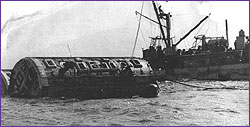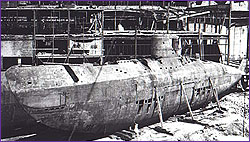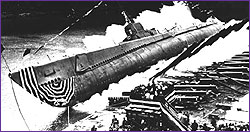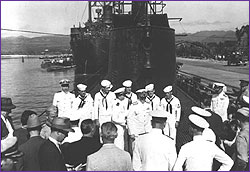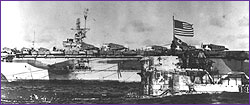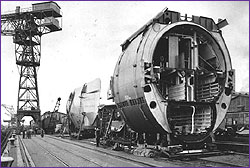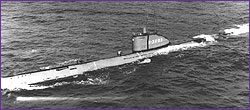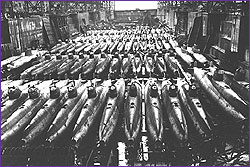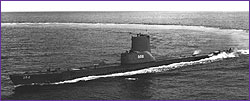 |

|
400 Years of Subs Introduction | 1580-1861 | 1861-1900 |1900-1918 1918-1939 | 1939-1945 | 1945-1972 | 1972-2000
While on sea trials, the spanking new U.S. Navy Squalus, SS-192, sank in 240 feet of water when an incompletely closed valve caused flooding in the engine room. Twenty-six men were killed in the flooded section; thirty-three men survived. All were safely brought to the surface in four round-trips using the McCann submarine rescue chamber. Salvaged and renamed Sailfish, the boat served to the end of World War II. 1939 Ten days after the Squalus disaster, a junior officer opened the inner door of a flooded torpedo tube and inadvertently sank the British submarine Thetis. A few men got out through an escape hatch, but 99 were lost. The British subsequently developed an on-board escape system, whereby sailors waiting their turn to go out through a pressure-modulated airlock would be able to breathe through individual oxygen masks permanently stored in the fore and aft torpedo rooms. The British also developed positive interlocks to prevent a recurrence, salvaged the Thetis and put it back in service renamed Thunderbolt. She was lost in combat in 1943. 1939 When Hitler told Dönitz early in the year that he was planning for a war six years in the future, Dönitz developed plans for the construction of a U-boat fleet of 300 Type VII boats. This would allow for 100 on station, 100 in transit, and 100 in training or under repair. However, Germany moved into Czechoslovakia in March and invaded Poland on September 1. On the 3rd, the British issued an ultimatum: Get out of Poland. You have two hours to make up your mind. The Germans did not respond. World War II began. Germany then had 57 U-boats in service, only 38 of which could be considered 'seagoing.' For the time being, it would be enough. 1939 The U-boat war started under "prize rules," but that policy did not last long. On the very first day, U-30 sank the liner Athenia without warning, and 122 of 1,100 passengers perished, including 28 Americans. The German High Command tried to pretend that the sinking was caused by a time bomb planted by the British to inflame public opinion against Germany. As late as January 1940, Minister of Propaganda Joseph Goebbels was ordering his staff "to continue running the Athenia propaganda ... bearing in mind the fundamental principle of all propaganda, i.e., the repetition of effective arguments." The German public did not learn the true story until after the war. Toward the end of September, the High Command authorized "seizure or sinking without exception" for merchant ships trying to radio for help when ordered to stop. A week later, U-boats received the order to sink without warning any ship sailing without lights, with commanders instructed to enter a note in the log that the sinking was "due to possible confusion with a warship or auxiliary cruiser." By November, the Germans had withdrawn all pretense with Standing Order No. 154: "Rescue no one and take no one aboard . . . Care only for your own boat and strive to achieve the next success as soon as possible! We must be hard in this war." 1939 Dr. Ross Gunn of the U.S. Naval Research Laboratory suggested that "fission chambers" using an isotope of uranium, U-235, could power submarines. In a Saturday Evening Post article a year later, a science writer noted that one pound of U-235 has the equivalent energy of five million pounds of coal: "A five-pound lump of only 10 to 50 percent purity would be sufficient to drive ocean liners and submarines back and forth across the seven seas without refueling for months." 1940 German scientist Helmuth Walter demonstrated a prototype for the first true submarine, a boat that in theory could operate submerged for an indefinite period, unlimited by battery capacity or the need for atmospheric oxygen. V.80 gained its power from the decomposition of highly concentrated (95 percent) hydrogen peroxide, H2O2, known as Perhydrol. In essence, when the chemical breaks down, it releases superheated steam to drive a turbine along with oxygen to support conventional combustion for additional power or for crew respiration. V.80's designer optimized its hull shape for submerged operations, and the boat indeed demonstrated exceptional speed—28 knots submerged. It also demonstrated exceptionally high fuel consumption, 25 times that of a diesel engine, at exceptional cost. According to one source, one six-and-a-half-hour trial run consumed $200,000 worth of Perhydrol.
1940 The U.S. Navy ran depth-charge tests against an operational submarine that, for most of the test, was moored underwater without a crew. Finding that 300 pounds of TNT was not very effective, they doubled the explosive charge. 1940 In June, France signed an armistice with Germany, and soon three French bases gave U-boats more convenient access to the open ocean. The 18 months between July 1940 and December 1941 were known, to the German submarine force, as the "happy time." 1940 Fleet headquarters in Germany directed U-boat operations by long-range radio. The Germans assumed the Allies would intercept the traffic but didn't care, because they were encoding all messages. However, even coded intercepts were useful; the Allies could identify many individual boats by their unique radio signature. Even if an Allied plane or ship could not establish a submarine's firm position, an analyst could determine when a boat would be near the end of a mission and therefore headed home along one of several reasonably predictable routes. 1940 Italy joined Germany in June, bringing 105 submarines to the Mediterranean theater. They do not seem to have had much impact.
In ramping up in anticipation of war—or, put more delicately, considering the then overwhelming public support for continued neutrality, as a "just in case" prudent measure—U.S. submarine production jumped from six or seven a year through the mid-1930s to 71 for FY1941. The Navy settled on Gato, SS-212, laid down in October 1940, as the template. Specifications: 312 feet, 1,825 tons, range 11,400 miles, 24 torpedoes. Over time the Americans made improvements, including a thicker pressure hull, beginning with the otherwise more or less identical Balao, SS-285. 1940 On August 17th, Hitler formally declared a total blockade of the British Isles. Desperate to acquire more escorts, British Prime Minster Winston Churchill struck a deal with U.S. President Franklin D. Roosevelt: a loan of 50 over-age World War I American destroyers in exchange for long-term leases for base facilities in Newfoundland, Bermuda, British Guiana, and the West Indies. 1940 The first Wolf Pack went into operation in September. Whereas in World War I the simple fact of 'convoy' kept the U-boats at bay, the Wolf Pack tactic instigated a series of long-running battles. Early in the war, escorts were lacking, and escort coordination was minimal. Often, before meeting up in ocean, escort vessels had not even talked with one another, much less trained together. One example: On October 16, one U-boat spotted a convoy of 35 ships and called in the rest of his pack, six more boats. Another boat joined the next day. After three days, the U-boats had sunk 17 of those ships, had intercepted two other convoys, and sent 21 more ships to the bottom, without a single U-boat loss. The tally would have been higher, but most of the submarines had fired all of their torpedoes and had to go home to re-load. 1940 At the end of the year, a German Naval Staff study noted the 'accomplishments' of the U-boats, but called for the building of more battleships, taking shipyard resources away from submarine construction. At the time, a handful of operational U-boats—often, not more than ten at a time—were sinking twice as many ships as the surface fleet. To enhance morale among civilians and sailors alike, a book of fiction and a feature movie showed Wilhelm Bauer battling bureaucracy and professional intransigence to reach the forefront of heroes ("Corporal Wilhelm Bauer, the first man who dove into the twilight..."). (See 1850.) 1940 By December, newly perfected aircraft-mounted radar could pick up a surface-running U-boat at seven miles. Not a great distance, but farther than the eye could see at night. It was a start. 1941 America's role as a 'neutral' was somewhat fuzzy. A steady stream of supplies flowed by convoy across the Atlantic, protected for much of the journey by U.S. Navy resources. After U-boats sank an American merchantman in May and a U.S. destroyer on October 30, with the loss of 115 sailors, public opinion, which had been about 70 percent in favor of continued neutrality, began to shift. 1941 The code-breaking effort dubbed 'Ultra' cracked the German Navy code. Beginning in June, the Allies could read much of the U-boat radio traffic off and on throughout the rest of the war, depending on whether the Germans had implemented new codes. (See Decoding Nazi Secrets.) 1941 In August, U-570 became the first and only submarine ever captured by an aircraft. Under attack, she surfaced and surrendered, and an arriving escort ship took control. U-570 subsequently entered the Royal Navy, where, redesignated Graph, she served until she was wrecked off the west coast of Scotland in March 1944. 1941 In August, Hitler demonstrated a constitutional inability to keep hands off and let his commanders run the war. Against all advice, in a misguided effort to protect his supply lines to North Africa, he ordered a shift of submarines from the Atlantic to the Mediterranean. (Misguided? How, indeed, could a submarine protect a surface ship against the principal threat, air attack?) This soon led to an order to shift all operational boats from the Atlantic theater, at a time when there were Atlantic targets aplenty and good weather in which to attack them. The submariners' "happy time" soon came to an end. 1941 On December 7, Japan attacked the American naval base at Pearl Harbor, Hawaii. The Japanese had 25 I-boats on station around the islands, but the submarines did not encounter any American warships. In addition, five HA midgets attempted to penetrate the harbor before the air attack began, but they achieved nothing but their own destruction. One became the first casualty of the Pacific war, sunk by the destroyer Ward before the air attack had begun as an unauthorized interloper in the offshore defensive sea area. The destroyer sent a flash message to headquarters, which thought it might be a false alarm. The battle fleet was seriously damaged in the Japanese air attack, but in time all ships were back in service except for two obsolete battleships: Arizona, sunk at her moorings, and Oklahoma, which sank while under tow back to the west coast for repairs. The major effects of the attack: to coalesce American public opinion as never before, and to force the U.S. Navy to abandon an ingrained fascination with battleships and shift the burden to the new-generation warships: the aircraft carrier and the submarine. At that time, the U.S. Navy had 111 submarines in commission, including 60 in the Atlantic and 51 in the Pacific, but many were barely capable. They commissioned Gato at the end of the month, yet it would be several years before a fully capable submarine force was in place. 1941 On the first day of the war, 28 submarines of the U.S. Asiatic Fleet stood in defensive positions around the Philippines. That was more submarines than the entire German U-boat fleet at the beginning of World War I; indeed, it represented more submarines than had ever been assembled for one battle at the same time. But they might as well have been in San Diego. For the losing three-week Philippine campaign, with potential targets including 76 loaded transports and supply ships, the Americans averaged only two attacks per submarine and sank only three Japanese ships. On the flip side, only one American submarine was lost. But that is not meant as a compliment. Pre-war training had emphasized caution: "It is bad practice and is contrary to submarine doctrine," noted an official report of 1941, "to conduct an attack at periscope depth when aircraft are known to be in the vicinity." Of more significance were problems with torpedo supply and design. As for supply: 1941 torpedo production was limited to 60 a month. For all of 1942, even with a war well underway, total production was 2,382. Submarine commanders, already too cautious, were cautioned not to waste their precious ammunition. For the year, they fired 2,010. As for design: The Americans, British, Russians, and Germans all had similar problems with their torpedoes. The depth settings were wrong, the fuses were inadequate, the torpedoes did not explode on contact. Example: during one period in 1940, U-boats launched four attacks on a battleship, 14 on cruisers, 10 on destroyers, and 10 on transports; they sank one transport. The leading U-boat ace Gunther Prien complained, "I cannot be expected to fight with a dummy rifle." In all navies, senior management did not give credence to reports coming in from the fleet. The submariners themselves, who after all had the most to gain (and lose), continued to complain until someone took notice, or they conducted their own indisputable tests. Amazing to note: Some of these problems were holdovers from World War I, and others were well known in the 1930s. The Germans solved their problems toward the end of 1940. Before the U.S. Navy had discovered and fixed its own problems—an effort that took the first two years of the war—their submarine commanders had fired almost 4,000 torpedoes against the enemy, with only marginal results. On one patrol, for example, Halibut fired 23 torpedoes; only one exploded, though one of the targets sank when the torpedo punched a hole through rusting hull plates. The U.S. tally for all of 1942—180 ships, 725,000 tons—was about equal to a monthly U-boat total. The Japanese replaced 635,000 tons in the same period. As far as the undersea forces were concerned, it looked like it was going to be a long war. 1942 Japan began construction of the 5,223-ton I-400 class of submarine aircraft carrier. Designed for attacks against the Panama Canal and the U.S. west coast, each carried three dive-bomber seaplanes. They planned for 12 but built only two, which never saw any useful service. Japanese submarines also made some attacks on the west coast, lobbing shells at Santa Monica, California and Astoria, Oregon. The attacks had minor effect, although Radio Tokyo gloated, "Americans know that the submarine shelling of the Pacific coast was a warning to the nation that the paradise created by George Washington is on the verge of destruction." 1942 Dönitz had hoped to send a blitzkrieg of U-boats against the eastern seaboard of the U.S., but Hitler, fearful of an Allied invasion of Norway, forced him to keep most of his assets closer to home. Dönitz nonetheless managed to get five long-range cruisers into position in January, where they found the whole coastline lit up like Times Square on New Year's Eve: no blackouts, all navigational aids aiding, all ships sailing with full navigational lights. With the war 3,000 miles away, it was high tourist season in Miami, and the northward-flowing Gulf Stream just a few miles off the coast kept southward-bound ships close inshore, nicely silhouetted against a glowing Florida skyline. The tally for two and a half months in American coastal waters: 98 ships. Coastal communities did not go under blackout until April. 1942 The Battle of the Atlantic began in July and continued for 11 months, with U-boats claiming some 712 merchant victims. They were sinking ships at more than twice the replacement rate, and new U-boats were joining the fleet at a rate of about one a day. Also in July, the Germans began deployment of a mid-ocean filling station. The Type XIV boat had a capacity for 700 tons of fuel and other supplies rather than armaments. Dubbed the "Milk Cow," this submarine could keep a dozen Type VII boats at sea for another month or five Type IX boats for two months. 1942 On September 13, in what may be the most spectacular, if unplanned, submarine event of all time, the Japanese I-19 launched a spread of six torpedoes at the aircraft carrier Wasp. Three hit, sinking the ship. The others continued running for twelve miles into another task group, where one caused fatal damage to the destroyer O'Brien and other sent the battleship North Carolina to the shipyard for two months. The sixth cruised on into the unknown. 1942 Technological advances such as improved radar, the radar altimeter, the aircraft searchlight, and effective air-dropped depth charges began to enter the force. Before long, aircraft could claim participation in 50 percent of all U-boat sinkings. 1942 In September, Dönitz issued a corollary to Special Order 142: "Be hard. Think of the fact that the enemy in his bombing attacks on German towns has no regard for women and children." He put his finger on the reality of modern war: All is 'unrestricted.' 1942 By the end of the year, with the U-boat fleet clearly in trouble, Hitler authorized the design of a fully combat-capable, Walter-cycle, 1,600-ton U-boat designated Type XVIII. Two prototypes were ordered, but it soon became clear that not enough time or money existed to turn this dream into reality. The Germans converted the design into a conventionally powered submarine—diesel on the surface, batteries for submerged running—and the rather large space intended for storage of the Perhydrol was given over to an extra-large bank of batteries. The Germans ordered two new classes. The 1,600-ton Type XXI had only half the range of the comparable Type IX, could manage bursts of 17 knots underwater (compared with seven knots in the Type IX), dive to almost 1,000 feet (300 feet deeper), and remain totally submerged at economical creep speed for 11 days. With a sophisticated fire control system, the Type XXI could launch an attack from a depth of 150 feet. The 230-ton coastal submarine Type XXIII, meanwhile, had twice the submerged speed and five times the underwater endurance of the small pre-war Type II. However, combat effectiveness was severely limited: two torpedoes, no reloads. The Germans quickly phased out all other submarine construction in favor of Type XXI and Type XXIII. 1943 Hoping to hide existing U-boats from increasingly devastating air patrols, the Germans perfected an idea that had been kicking around for a long time: use of a breathing tube to allow running on diesel power just below the surface, thus also keeping the batteries fully charged. They dubbed it the 'snorkel.' It was not a perfect solution. The tube could break if the boat was going too fast, and the ball-float at the top would close if a wave passed over, thus shifting engine suction to the interior of the boat and occasionally popping a few eardrums. The snorkel also left a visible wake and returned a pretty good radar blip. But it helped. 1943 The Germans underestimated the industrial capacity of the U.S. The prediction under which "Tonnage War" was by then being waged was that the 1943 ship production of Great Britain and the U.S. together would be less than eight million tons. The U.S. alone launched more than double that figure. The Germans also underestimated the ability of the Allies to develop and implement highly effective anti-submarine weapons and tactics. During the year, the U.S. Navy established anti-submarine "Hunter-Killer" groups centered on a small, quickly built so-called 'jeep' carrier, from which perhaps a dozen airplanes might operate. Long-range aircraft went into service, including the B-24, which was adapted for anti-submarine efforts. Among other efforts, they put an end to the "Milk Cow." The rendezvous were too easy to spot by air patrol. Of nine Type XIV in service in June 1943, seven had been sunk by August. Also operational: the 'hedgehog,' so-named because the array of two dozen 65-pound projectiles looked like the bristles of a porcupine. Launched 230 yards in front of a surface warship, the projectiles would cover a 100-foot circle, exploding on contact. The weapon proved highly effective. By the end of May 1943, the Germans had clearly lost the Battle of the Atlantic. In that month alone, the Allies sank 41 U-boats, representing 25 percent of Germany's current operational U-boat strength. Things got worse: In the final four months of the year, during which almost 5,000 ships sailed in Atlantic convoys and only nine were lost, the Allies destroyed 62 U-boats. 1944 As in World War I, only one verified German submarine atrocity is on record. In March 1944, U-boat commander Heinz Eck, on his first combat mission, ordered his crew to kill all survivors of the Greek merchant steamer Peleos and to try to pulverize all floating wreckage with hand grenades. His motive: to hide the sinking from patrolling aircraft and thus conceal his own presence in the area. Three survivors later testified in a post-war trial; Eck and two of his officers, who claimed they were only "following orders," were convicted and executed.
In June, a "Hunter-Killer" group became the first American force to capture an enemy warship on the high seas since the War of 1812. Depth charges forced the Type IX boat, U-505, to the surface; quick action by a boarding party saved the boat from being scuttled by her crew. U-505 is now a permanent exhibit at Chicago's Museum of Science and Industry. 1944 In a reprise of the Deutschland efforts of World War I to move high-priority cargo through the blockade, the Japanese sent the cargo-carrying I-52 (356 feet long, cruising range of 27,000 miles at 12 knots) from Indonesia with a cargo of rubber, tin, opium, quinine, tungsten, molybdenum, and two metric tons of gold bullion, bound for Nazi-occupied France. Allied radio intercepts had pinpointed a mid-ocean rendezvous with U-530, to transfer a coast pilot, a radar technician, and some new radar equipment to assist I-52 in running the Allied gauntlet. Sunk on June 23, 1944 by an aircraft from the jeep-carrier USS Bogue, I-52 was discovered in May 1995 under 17,000 feet of water. 1944 The American version of code-breaking, dubbed the "Pacific Ultra," allowed the fleet to plot Japanese merchant convoys in advance—no need for long open-ocean hunting expeditions. As the existing submarine force was running out of targets, the U.S. radically scaled back submarine production early in the year. With perhaps 140 submarines operating in the Pacific, U.S. Navy submarines sank more than 600 Japanese ships, 2.7 million tons—more than for the years 1941, 1942, and 1943 combined. As targets disappeared, the Navy assigned many submarines to picket duty to rescue downed aviators making B-29 raids on Japan, or anyone else who happened along. The boats hauled aboard a total of 540 individuals, including the youngest pilot in the U.S. Navy, Lt(jg) George Bush. 1944 On November 28, the U.S. boat Archerfish sank the largest ship ever sunk by a submarine, the newly minted 71,890-ton Japanese aircraft carrier Shinano.
Japan fielded the Kaiten suicide torpedo, incorporating elements of the 24-inch, 40-knot version of the Long Lance, with a control compartment into which the pilot was locked. Range: not more than five hours, no matter what. I-class submarines carried Kaiten into battle, and a fairly large number went into action. The record is ambiguous, however. They did succeed in sinking one American tanker and a small landing ship, perhaps also a destroyer escort, as well as damaging two transports. 1944 Germany also pursued weapons of desperation, developing a two-man, two-torpedo midget submarine called the Seehund. Thirty-nine feet long and weighing 15 tons, Seehund could dive to 165 feet with a surface range of 120 miles at eight knots or 250 miles at five knots; submerged, 20 miles at five knots, 60 miles at three knots. When the war ended in May 1945, the Germans had at least 268 Seehunds ready for service. To minimize the effect of Allied bombing, the Germans built late-war Type XXI boats in virtually complete sections at scattered locations and transported them by barge to assembly yards.
Germany's largest U-boat, the 1,700-ton Type XB minelayer U-234 found itself at sea when the war ended and surrendered in mid-ocean to an American destroyer escort. Her original destination had been Japan. Her cargo included two complete ME-262 jet fighters (disassembled in crates, but with complete technical data) and 550 kilograms of Uranium 235 (or Uranium oxide—sources differ), packed in lead containers. No one has ever determined—or at least revealed—the reason the Germans were sending the uranium to Japan. 1945 How each country's submarines fared during the war: Germany: U-boats claimed 14.4 million tons, but Germany lost 821 U-boats (see Map of Lost U-Boats). Allied aircraft were responsible for (or directly involved in) the loss of 433 U-boats; surface ships, 252; accidents, 45; mines, 34; submarines 25 (only one of which happened when both hunter and victim were submerged); unknown, 15; scuttled by their own crews, 14; interned in neutral ports, 2; sunk by shore battery, 1. United States: American submarines sank at least 1,300 Japanese ships, 5.3 million tons, including one battleship, eight carriers, 11 cruisers, and 180 smaller warships. The U.S. Navy lost 52 boats; 22 percent of the submarine personnel who went on patrol did not return. It was the highest casualty rate of any branch of service, though not as high as that of the German submarine force, which lost an astonishing 630 men out of every 1,000 who served in the U-boat fleet. Soviet Russia: The Soviets started the war with the largest submarine fleet: 218. They added 54 and lost 109. They did not have much impact on the course of the war, though S-13 was credited with the single greatest disaster in maritime history: the 1945 sinking of the German liner Wilhelm Gustloff, which was engaged in an effort to get German soldiers out of the path of the advancing Red Army. More than 8,000 troops and civilians may have been aboard; fewer than 1,000 were rescued. Japan: Japanese submarines had great success early in the war, especially in the Indian Ocean area. But the tide of battle began to turn with the Allied invasion of Guadalcanal in August 1942, and the Japanese pulled submarines off combat duty and assigned them to carry vital supplies to beleaguered troops or to pull troops out of failing campaigns. The Japanese built submarine landing ships and 28 cargo submarines. Japanese submarines did score a few important victories, including the carriers Yorktown and Wasp and the last American surface warship sunk, the cruiser Indianapolis in late July 1945. Overall, however, they sank only about one-fifth as many ships as the American submarine force did.
1945 Dönitz, who started the war as commander of submarines, became Navy Chief of Staff in January 1943 and ended the war as Hitler's chosen successor as Chief of State, even though he had never been a member of the Nazi Party. After Hitler committed suicide on April 30, Dönitz assumed command (on May 1) and issued cease-fire orders (on May 3). The 1945 Nuremberg War Crimes tribunal brought Dönitz up on charges, especially for "breeches of the international law of submarine warfare" for authorizing and encouraging unrestricted operations. The best witness in his defense: U.S. Admiral Chester Nimitz, who acknowledged that the U.S. Navy had authorized unrestricted operations against Japan throughout the Pacific Ocean from the first days of the war. Nonetheless, Dönitz was sentenced to ten years imprisonment for being "fully prepared to wage war." It was a specious charge in the eyes of most observers, for any military force should always be thus prepared. Most observers believed he was tried in place of the unavailable Hitler. The U.S. Navy took two Type XXI boats and a handful of Japanese submarines for study and applied some lessons learned to a fleet upgrade dubbed "Greater Underwater Propulsive Power" (GUPPY). Continue: 1945-1972 Tour U-869 | Sole Survivor | Hazards of Diving Deep 400 Years of Subs | Map of Lost U-Boats | Fire a Torpedo Resources | Transcript | Site Map | Hitler's Lost Sub Home Editor's Picks | Previous Sites | Join Us/E-mail | TV/Web Schedule About NOVA | Teachers | Site Map | Shop | Jobs | Search | To print PBS Online | NOVA Online | WGBH © | Updated November 2000 |
